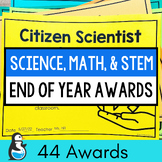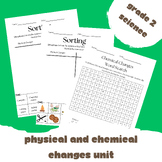10 results
Environment Common Core HSN-Q.A.1 resources
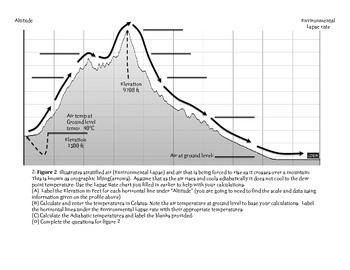
Death Valley: A Case Study of Earth Systems Interactions on Climate
This is a very thorough student driven investigation intended to show the inter-relationships between weather concepts as well as the interactions of earth's major systems. How does the Pacific ocean, the Sierra Nevada Mountains, and prevailing winds make death valley one of the most inhospitable places on earth? Students will calculate, research, and take data to delve deep into applying concepts including humidity, phase change, latent heat, lifting, adiabatic lapse rates, and trends of temp
Subjects:
Grades:
9th - 12th, Higher Education, Adult Education
Types:
CCSS:

Recycled Art Project for Science Students
This was developed as part of a Waste unit for an Environmental Science class I was teaching at an arts school. It is intended to be an integrative and interdisciplinary hands-on approach to introducing concepts of reusing and recycling nonrenewable resources. This is a group project that works ideally with 4-8 groups of 4 students. The resource includes both a group sheet (one per group) and an individual sheet (one per student). Both sheets have rubrics. As students worked, I walked around wit
Subjects:
Grades:
6th - 11th
Types:
NGSS:
HS-ESS3-2
, HS-ESS3-4
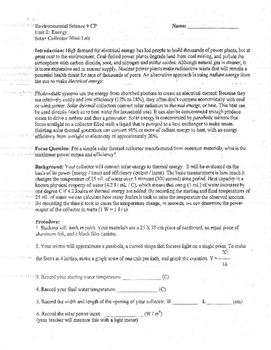
Environmental Science Energy Lab and Power Plant Calculations
This inquiry based lab activity is designed to help students to understand where the energy that we use in our every day lives comes from and how much energy different power plants generate to help us meet those needs.
Students will design their own Solar Energy Collector and measure its power output and efficiency. Students will also investigate and design a wind turbine and calculate it's output and efficiency.
Subjects:
Grades:
9th - 12th
Types:
CCSS:
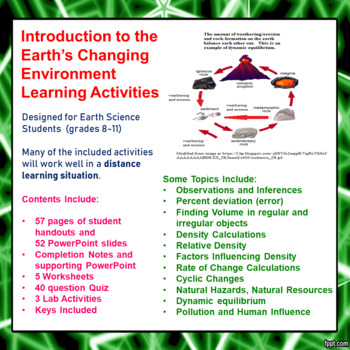
Intro to Earth's Changing Environment Learning Activities (Distance Learning)
This zip file contains many different activities (57 pages of student handouts and 2 PowerPoints with a total of 126 slides) which can be used to compose a unit introducing the earth's changing environment. Concepts addressed include observations, inferences, percent deviation (error), finding volume, density, rates of change, cyclic changes, dynamic equilibrium and many others. The learning objectives and specific contents of this set of materials is listed below. This set of activities is s
Subjects:
Grades:
8th - 11th
Types:
CCSS:
NGSS:
HS-ESS3-3
, HS-ESS3-1
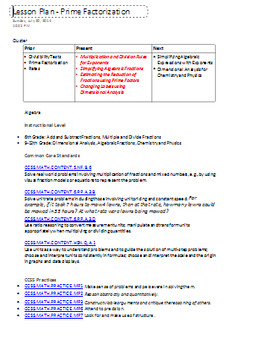
Dimensional Analysis
This is a complete lesson for teaching Least Common Multiple and Greatest Common Factor by using Prime Factorization.
² Lesson Plan
○ Cluster of Prior, Present, and Next Learning Targets
○ Common Core Standards
○ Common Core Practices
○ Materials
○ Instructions and Suggestions
○ Outcomes, Assessment , and Closure Ideas
² Flipped Lesson Assignment - Scaffolding
² Cornell Notes Template
² Guided Case Study for Cooperative Learning Activity
○ Harry Potter "The Cost of Wizardry
Subjects:
Grades:
5th - 10th
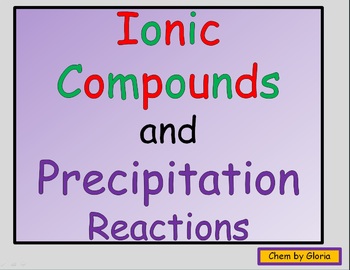
Formation of Ionic Compounds & Precipitation Reactions
The PowerPoint contains over 80 slides and primarily includes instructional slides covering ionic compound formation. Students will practice how to build ionic compounds using the correct ratios of positive and negative ions. The emphasis is on how to build ionic compounds with many different ions that may not have a 1:1 ratio. Also students will practice how to calculate the formula mass of the ionic compound formed based on the ratio of positive and negative ions. In addition students will
Subjects:
Grades:
8th - 12th
CCSS:
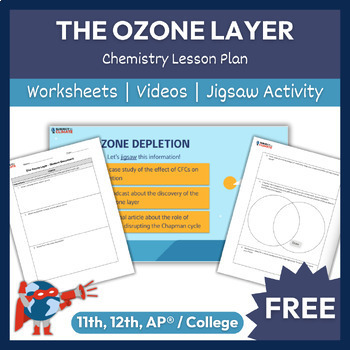
Chemistry Lesson Plan & Activity | Ozone Layer | Gr 11-12+
Discuss atoms and molecules with this 90-minute lesson for 11th, 12th, and AP Chemistry students. They'll explore the chemistry behind the ozone layer's depletion and recovery, understand the Chapman cycle, and craft a social media post inspired by the Montreal Protocol. Within this lesson you will find a Teacher Slideshow, student worksheets, assignment rubric, a jigsaw activity, and a teacher answer key, all accessible via Google Docs!★ Access Free Lesson Plan Here ★★ Meet the Teacher: Greta S
Subjects:
Grades:
11th - 12th, Higher Education
CCSS:
NGSS:
HS-PS1-1
, HS-PS1-4

Chemistry, Fertilizer, and the Environment
This five-lesson unit for grades 8-12 uses agriculture to introduce students to chemistry and environmental science concepts. Activities are modeled after real-life challenges that modern farmers face while producing our food, fiber, and fuel. Labs are inquiry based and promote critical thinking skills.Supplemental Content:From Lesson 3: Molecular Shuffle PowerPointNitrate Test Strip Color ChartThe California Foundation for Agriculture in the Classroom is a nonprofit organization dedicated to ed
Subjects:
Grades:
8th - 12th
Types:
NGSS:
MS-ETS1-2
, HS-ETS1-2
, MS-LS2-2
, HS-PS1-1
, MS-LS2-3
...

High School — Lesson 1: Water Resources and Water Footprints
This lesson gives students an in-depth understanding of key water issues. They learn about water resources and water footprints, then use the Water Footprint Calculator to analyze their direct and virtual water consumption. Students get a foundation of knowledge and learn why they should care about protecting water resources, which makes it easier for them to make a fundamental shift in attitude about their water use. Designed for high school – upper secondary level, ages 15 to 18 – the lessons
Subjects:
Grades:
9th - 12th, Higher Education
Types:
NGSS:
HS-ESS2-4
, HS-ESS3-1
, HS-ESS3-5
, HS-ESS3-6
, HS-LS2-1
...
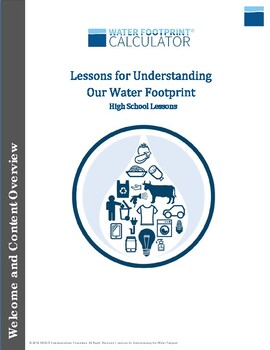
Overview: Lessons For Understanding Our Water Footprint
This is an overview of the Water Footprint Calculator lesson plans. You can find all of the free lesson plans at Watercalculator.org: https://www.watercalculator.org/resource/water-footprint-lessons/“Lessons for Understanding Our Water Footprint” will help students recognize that water is a limited resource that needs to be conserved. These lessons will promote conversation about how students’ food choices and shopping habits have a larger impact on their water consumption than they may realize.
Grades:
6th - 12th
Types:
Showing 1-10 of 10 results


